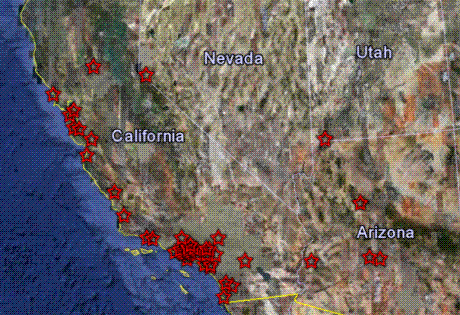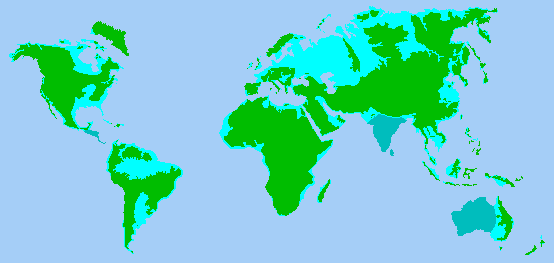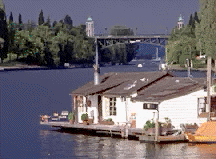Fireballs Increase
Fireballs have been raining down on Canada and Europe recently. The Zetas warned that as the tail of
Planet X turned toward the Earth that the debris in the tail would increasingly become evident. This
results in fireballs and meteors as well as occasional electromagnetic disturbances. As mentioned in our
November 30, 2008 Newsletter, western Canada experienced the first fireball.
- Fireball streaks across Canadian Prairie, Crashes
November 24, 2008
http://blogs.usatoday.com/ondeadline/2008/11/it-came-from-ou.html
- The Canadian Prairie is still buzzing about a giant fireball that roared across the sky last
night and slammed into the earth with a bright flash.

If the Canada fireball was dramatic, the incidence of fireball sightings has exploded recently.
- Goodness Gracious Great Balls of Fire
January 21, 2009
http://bonnee.towerofbabel.com/2009/01/21/goodness-gracious-great-balls-of-fire/
- In the last 90 days there have been sightings in: California, Sweden, New Zealand, Middle
East, Canada, Africa, Argentina, Vancouver B.C., Colorado, West Virginia, Washington,
Oregon, Arizona, Ireland, Brazil, China and more.
During a period of days there was a spate of dramatic fireballs. The spate started in Sweden on January
17.
- Scandinavian Fireball Sightings
January 17, 2009
http://www.spaceweather.com/glossary/fireballreports_17jan09.htm?
- On January 17, 2009, at 1909 UT, a meteoroid of unknown size hit Earth's atmosphere
over Scandinavia and exploded with a thunderous, rumbling boom. The fireball was so
bright it turned the nighttime sky blue.

Then, on January 18, 2009 reports from California on a fireball seen over a four state area: California,
Nevada, Utah and Arizona. There were apparently two fireballs, the second occurring early the next
morning on January 19, 2009.
- More on the California Fireball - January 18
January 20, 2009
http://transientsky.wordpress.com/
- The fireball occurred on Sunday evening, January 18, at -5:30 pm (give or take 20
minutes). Amazingly this was only - 15 minutes after sunset for people on the coast so the
sky was still very bright. The fireball must have been quite a spectacle to be seen against
such a bright sky. Based on the reports submitted so far, it was seen from 4 states
(California, Nevada, Utah and Arizona). Here's a map of the sightings reported so far.
Most people said it was a white/blue though a few observers noted it changed into many
colors. This is consistent with a meteor. The fireball ended its passage through the
atmosphere with a bang, something astronomers call a "terminal burst". This marks the
final break-up, or explosion, of the small asteroid that created the fireball. Many reports
also mentioned that a smoky trail was visible for several minutes after.

- Another California Fireball
January 19, 2009
http://transientsky.wordpress.com/2009/01/19/another-california-fireball/
- I have received a few reports about a bright fireball seen across California. Sightings have
been sent in from San Francisco to San Diego. There is some disagreement on the time
with some people saying it occurred on January 18 around 5:40 pm PST and others saying
it happened on January 19 around 4 am PST. So perhaps we are talking about 2 unrelated
but spectacular fireballs, the evening one was seen over southern California while the
morning one was a northern CA object.
A blog posting from Arizona confirms that the fireball was seen over a broad area as it shrieked across
California.
- Fireball in Arizona Sky
January 18, 2009 10:47 pm
http://www.godlikeproductions.com/forum1/message708148/pg1
- I'm in Phoenix and at about 6:15 pm I was taking the family out for dinner when I saw a
fireball in the sky WNW of here. It was the biggest fireball I have ever personally seen. Did
anyone else see it? [and from another] I saw it looking east at about 75 degrees at 6:08 pm
with a yellow-orangish tail, bigger than a shooting star lasting a second or two from
Highway 4 traveling towards Murphys, CA (central Sierra Foothills)
Then New Zealand chimed in on January 19, 2009 with a report that officials claimed was a piece of
space junk re-entering the atmosphere. In light of the reports from Sweden and California, this excuse is
suspect, however. The New Zealand observatory spokesperson discussed whether it was a comet or a
meteor, when none of the observers were claiming this. Given the choice between a fireball or space
junk, the observatory chose to claim it as space junk. But then, observatories are under instructions to
downplay the presence of Planet X in the solar system. Apparently it is preferable to claim that our
satellites in space are raining down at an unprecedented rate.
- Bright Light in Southern Skies Thought to be Satellite
January 19, 2009
http://www.nzherald.co.nz/nz/news/article.cfm?c_id=1&objectid=10552548
- Queries about a bright light in the southern skies last night have been coming into the
Mount St John Observatory. A nzherald.co.nz reader, Shannon, also saw the light and said:
"I'm not 100% sure what it was, but it looked like a comet or something entering through
the atmosphere last night around 10.30 pm to 11 pm. "It was a bright white light and was
moving extremely fast to be a plane, and looked to be breaking up as it moved along, as its
colour changed to orange." Alan Gilmore, a resident superintendent at the Mount St John
observatory, said reports from Christchurch described the bright object in the sky shortly
after 10 pm that was visible for between two to three minutes and left a glowing trail
behind it. "My best guess was that it was a re-entering satellite. A comet does not move
like that, it stays more or less fixed against the background stars unless it is very close to
the earth, you need to watch it for two or three hours in order to see it moving," Mr
Gilmore said. He said it moved too slowly to be a meteor, which would be gone in two
seconds. "But everything fits with a re-entering satellite, that is a satellite that is heating
up because of the friction of the air, probably 100km or higher up in the air, it's glowing
white because it's heating up and it's leaving a trail of charged, excited atmosphere gas
which glows," said Mr Gilmore. He said the trail could have also have been smoke picked
up by the sun at such a high altitude. "That's my best guess," he said.
Following the spate on January 18-19, there was a fireball sighted in New England on January 24,
2009.
- Fireball Sighting
http://www.spaceweather.com/
January 24, 2009
- Observers in Massachusetts and Rhode Island are reporting a "huge, pulsating blue-green
fireball" sighted within minutes of 8:48 pm EST on January 23rd. It was bright enough to
be seen through heavy cloud cover, according to one witness.
More than debris in the tail of Planet X is becoming evident. Where most satellite failures can be kept
from the public by the ability of satellite providers to switch to backup satellites and loft more satellites
for saturation coverage, on occasion a satellite failure hits the news. This report is notable because no
excuses for the failure are offered. Note the date of this failure - January 23, 2009.
- Failed Telecommunications Satellite Drifts Out of Control
January 23, 2009
http://news.yahoo.com/s/space/20090123/sc_space/failedtelecommunicationssatellitedriftsoutofcontrol
- The Astra 5A commercial telecommunications satellite is out of control after an
unexplained failure Jan. 15 and is drifting eastward along the geostationary orbital arc,
with ground controllers pessimistic about their ability to re-establish sufficient
communications to guide it into a graveyard orbit.
ZetaTalk Comment 1/24/2009: We predicted satellite failure and satellites have been increasingly
failing. The articles announcing these failures no longer even try to offer excuses. Fireballs have
been also increasingly evident, as the tail of Planet X has been turning toward the Earth and
much debris is in the tail. This is a charged tail, being hosed out from the magnetic N Pole of
Planet X, and thus satellites get an onslaught of electromagnetic pulse on occasion as well as
being peppered by debris. This trend will only increase in the future.
Waterworlds
The Zetas have stated that the oceans of the world will rise to approximately 675 feet elevation,
worldwide, within two years after the pole shift. In the ZetaTalk map below, only the dark green land
areas will be above water at that time, per the Zeta prediction.
ZetaTalk Prediction 7/15/1995: Where new poles take centuries to fully form, existing poles thrust
under an equatorial sun melt rapidly. The melting poles will thus raise the sea level, worldwide,
by 650 to 700 feet within two years. Survivors living below this level will find themselves moving
repeatedly as rivers begin to overflow their banks and marsh areas become lakes. Those planning
survival sites should consider this as well as escape routes for survivors who might be trapped by
the rising water. Survival sites should be selected for their ability to link to other land areas that
will be above the water line as well, so that technologies and skills can be shared among the
survivors. Survivors thus will find visiting each other possible rather than impossible in a new
world without maps and certainly without guidelines for boats setting out on what will seem to be
an endless sea.

The Troubled Times forums spent some time discussing this issue as well as discussing hundreds of other
topics related to the pending pole shift. (Don't forget, you can get the entire Troubled Times website on
your own CDs at cost for $4.10, including postage, from the Troubled Times nonprofit.) Houseboat
living, where one could pull up anchor and move with the coastline, was one suggestion. Don't like your
neighbors? Just pull up anchor and move on. Houseboat living gives one the option of having both land
and water advantages. Fishing is right at hand, and a trip to land to collect supplies or barter fish for
garden produce is easily accomplished. Houseboats need floatation devices, normally some kind of
metal tube filled with air, but desperate survivors finding themselves on a shrinking island could get
resourceful. What about all those empty soda bottles, filled with air and tied into net sacks below a raft?
Plastic degrades slowly, so we are told. Dig around in the local landfill and float your new homes.

Another concept discussed on the forums was an aqua dome design. This design not only floats a
community in the water, but offers protection from winds and volcanic ash fallout. Of course, the menu
would almost always include fish, with such a floating community, but ocean kelp would also be
harvested.

A double dome concept was also introduced by Troubled Times members. Here the bottom dome
would be heavier than the top, ensuring stability in the water.

Recently an article was published with a floating city design. This is clearly designed to appeal to the
wealthy, however, with helioports and all.
- Live Free or Drown: Floating Utopias on the Cheap
January 19, 2009
http://www.wired.com/techbiz/startups/magazine/17-02/mf_seasteading
- The hypothetical dwelling looks like a giant dumbbell standing on end, with a large steel
ballast underwater and a 48,000-square-foot platform suspended above, where 120 people
could live. [1] Living Platform. The 160,000-square-foot steel expanse puts the cruise ship
lido deck to shame. Carbon-fiber cables anchored to the pillars reinforce the structure and
make possible a larger platform surface. [2] Water Supply. Water, water everywhere-and
plenty for you to drink! Desalination equipment provides potable freshwater and gray
water for gardening. [3] Foot Tanks. Leave the Dramamine ashore. Water tanks inside
four flotation pillars hold the seastead 30 feet above water and minimize the impact of
rogue waves. [4] Engine Room. Don't like your neighbors? Move! The island can travel at
speeds of up to 2 knots, powered by four diesel engines that double as electrical
generators.

The article describes several similar, but failed, attempts to establish a free port on the high seas.
- Live Free or Drown: Floating Utopias on the Cheap
January 19, 2009
http://www.wired.com/techbiz/startups/magazine/17-02/mf_seasteading
- There was Operation Atlantis, in the late 1960s. Started with a ferro-cement boat that
made a single successful voyage on the Hudson River. He erected a system of seabreaks
near the coast of Haiti but was run off by president Duvalier's gunboats before he could
put land on it. He bought an oil rig and tried to anchor it between Cuba and Honduras,
where it was destroyed by a storm. The Oceania city project, a plan for a vast floating
settlement off the coast of Panama, emerged in 1993. The founders took out a two-page ad
in Reason, a libertarian magazine. The project was disbanded the following year due to
lack of interest and funds. Other projects still exist as hypothetical concepts. There's the
Freedom Ship, a mile-long floating tax haven, which will come into being just as soon as
its organizers can drum up the $10 billion needed to build it. (They've accused their former
president of absconding with the first $400,000 they raised.)
The SeaScape project is in fact motivated less by the ultimate need to live on water and more by the
desire to evade laws such as taxation.
- Live Free or Drown: Floating Utopias on the Cheap
January 19, 2009
http://www.wired.com/techbiz/startups/magazine/17-02/mf_seasteading
- Seasteaders can depend on like-minded benefactors for only so long. Ultimately, they will
need to pay the bills. Friedman notes that some enterprises-like euthanasia clinics-would
incense local authorities, but almost all the ideas attendees come up with would capitalize
on activities that skirt existing laws and regulations: Fish farming and aquaculture.
Prisons. Med schools. Gold warehouses. Brothels. Cryonics intakes. Gene therapy, cloning,
augmentation, and organ sales. Baby farms. Deafeningly loud concerts. Rehab/detox
clinics. Zen retreats. Abortion clinics. Ultimate ultimate fighting tournaments.
Nevertheless, the concept of living on houseboats, in bays protecting the floating community from high
waves, is sound. In fact, it may become the future for many, regardless of building codes and the
competition for venture capital. It may be a concept forced on much of humanity by the coming pole
shift.
ZetaTalk Prediction 7/15/1995: Life in the oceans will not die out. The water will have a green
tinge. Little known among the populace, but well known among scientists, is that the ocean is one
of the largest producers of the atmospheric oxygen. After the cataclysms, the atmosphere oxygen
will be rebuilt from the oceans. The oceans will appear greenish to many, and for good reason.
All the fires will have placed a tremendous amount of carbon dioxide into the air, the stuff of
which vegetative grown is made of. With little vegetation on land, the ocean kelp will absorb and
utilize this. The oceans will be lush. Even those far inland should plan to take advantage of the
lushness of the oceans, the fish and kelp, to support humans survivors. As the oceans move this
food about, fish about, so fishing anywhere will be more abundant, compared to land life, in the
Aftertime. Life in large lakes, as well as oceans, will fare far better than land based life after the
shift. This is in part due to the way sunlight enters water, and the susceptibility of land based
vegetation to mold and bugs and physical assault and the like. Seaweed will not find more
assaults than before, but will find more nutrients. Where the sunlight may be less, they can parlay
any growth upwards, using all sunlight, where land based vegetation finds itself decimated
periodically, having to start over, etc. Thus, ocean fishing will be best, due to the broad space it
covers and the shared nutrient and fishlife resulting, but land lakes will likewise likely do better
than the shores.
Continental Drift
What causes the continents to drift apart? It is certainly well established that the Earth's tectonic plates
are separated from one another, having rough edges, and that there are fault lines within the plates'
interiors too.
ZetaTalk Comment 7/15/1996: Tearing of continents is less traumatic than it would seem to
humans, who imagine the continents as one plate and think of how lumber resists being torn,
metal bends and twists before tearing, and a rope of fibers resists while the fibers snap one by
one. Continents are in fact an overlay of many plates, and faults are where most of the plates
have fractured in the same place. The continents are attached because some of the plates have
not fractured. This concept should not be that hard to grasp if one considers that many land
faults have a slip-slide relationship of the plates, which are moving in different directions past
each other. This motion would not be possible if the plates were not, in fact, separate. Thus,
ripping apart of continents is no more traumatic than subducting or slip-sliding. The land along
the edges generally retains its altitude, as this was determined by the thickness of the plates, thus
its boyancy on the sea of lava. Solid land is composed to a great degree from the lighter
elements, which rose to the top during the early cooling of planet Earth, and thus formed the
floating crust.
But how can plate movement rip rock apart and push mountains to a higher elevation? What kind of
pressure is required to tear rock? Per the Zetas, it should not be termed "Continental Drift" but
"Continental Rip".
ZetaTalk Comment 2/15/1996: The Earth bears witness to the cataclysms in her past and their
periodic occurrence. Beyond her deep wound in the Pacific basin, and beyond the drift of her
continents, there are scars more palpable by man. Mountain cliffs, which rise sheer in many cases
thousands of feet, represent tearing of solid rock. These stands before mankind, who even make
a hobby of scaling their heights, ignored in their deeper meaning. Have any experiments been
done to determine how much force would be required to tear rock of this depth? None have. The
reason lies in the equally deep desire of mankind to avoid thinking about the Earth's past
cataclysms. Beneath the sea in the Bahamas lies evidence of civilizations that went under the
waves - highways and highway markers, clearly manmade. These areas have been explored by
many fortune hunters, recorded by camera, and published in full color repeatedly. Likewise
ancient Incan cities stand so high in altitude that the cities could not have been built, much less
lived in. Yet the scientific community continues to claim that Earth changes happen gently, inch
by inch, at the pace experienced during the memory of their current civilization.
Of course crustal shifts that happen during the periodic passage of Planet X are the explanation for
continental rip as well as the Ice Ages and evidence of wandering poles. But in attempting to comfort
themselves that such a disaster will not occur during their lifetime, scientists sometimes come up with
positively silly explanations. The continents, per this most recent theory, are on the move, driving
mountains high and ripping the Atlantic apart, because of heat rising from the interior of the Earth.
- The Continents As A Heat Blanket
January 26, 2009
http://www.terradaily.com/reports/The_Continents_As_A_Heat_Blanket_999.html
- Drifting of the large tectonic plates and the superimposed continents is not only powered
by the heat-driven convection processes in the Earth's mantle, but rather retroacts on this
internal driving processes. In doing so, the continents function as a thermal blanket, which
leads to an accumulation of heat underneath, and which in turn can cause the break-up of
the super-continents. The enormous heat in the Earth's core and Earth's mantle generates
the flow of rocks within the Earth's mantle, a process similar to the movement of warm
water in a cooking pot. This heat-driven mass transport is called convection. On the
Earth's surface, this process leads not only to plate movement but also to drifting of the
continents floating on the plates.
You received this Newsletter because you Subscribed to the ZetaTalk Newsletter service. If undesired, you can quickly
Unsubscribe.
|

